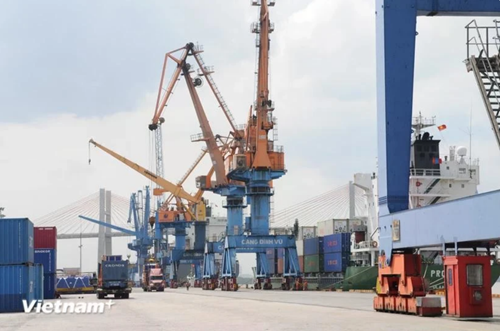According to the National Statistics Office, these five sectors dominate Vietnam’s exports to the U.S., with many businesses heavily reliant on the North American market. As a result, they are likely to suffer the most from the trade measures.
Dr. Bui Quy Thuan, deputy head of the research division at the Vietnam Industrial Park Finance Association (VIPFA), acknowledged the immediate challenges to the country's exports and economy, but viewed them as an opportunity for Vietnam to make long-term changes as it is pressing on with institutional reforms, economic policies, and science - technology development.
    |
 |
|
Vietnamese businesses are advised to seek new markets to adapt to the new situation. (Photo: Vietnam+) |
He perceived that higher tariffs could push Vietnam to accelerate export market diversification by leveraging its 17 free trade agreements (FTAs) such as the EVFTA, CPTPP, and RCEP, or exploring new markets like the Middle East, Northeast Asia, North America, and Africa so as to reduce overdependence on the U.S. market. Additionally, the domestic market, with a population of over 100 million, could also generate new opportunities for businesses.
Vietnam should continue bilateral negotiations with the U.S. administration on major export commodities while guiding businesses in diversifying markets, attracting more U.S. investments, and increasing purchases of goods from the U.S. Maximizing FTAs, accelerating economic policies like public investment promotion to stimulate demand, supporting private sector development, and facilitating innovation and science - technology advancement should be prioritized. Besides, enhancing the competitiveness of Vietnamese enterprises by improving the business environment more substantively is also crucial, according to Thuan.
He recommended businesses invest more in technology, accelerate digital transformation, and adopt greener production methods to meet international standards. Research and development, market expansion, and technology application are essential for cutting expenses and producing distinctive products to stay competitive without worries about tariff risks or non-tariff barriers of large trading partners.
Highlighting that the U.S. remains one of the top three importers of Vietnamese fruits and vegetables, Chairman and CEO of Vina T&T Group Nguyen Dinh Tung urged the Government to clarify which products post a trade surplus and which are benefiting U.S. buyers.
He said businesses will seek new markets to adapt to the new situation but also hope to receive support in cost reduction and market stabilization.
Dang Phuc Nguyen, Secretary-General of the Vietnam Fruit and Vegetable Association (Vinafruit), pointed out that Vietnam currently runs a trade deficit with the U.S. in the sector. In 2024, Vietnam’s fruit and vegetable exports to the U.S. reached 360 million USD, while imports from this market stood at 540 million USD.
He reassured businesses that not all products are subject to the 46% tariff, and that the fruit and vegetable sector may remain unaffected.
Nguyen stressed that companies should focus on optimizing every stage of production, from raw materials to logistics, to minimize costs and remain competitive against the nations facing lower U.S. tariffs.
Source: VNA